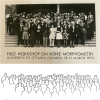Celebrating 50-years: the history and future of the International Society of Bone Morphometry
- PMID: 38868596
- PMCID: PMC11166892
- DOI: 10.1093/jbmrpl/ziae070
Celebrating 50-years: the history and future of the International Society of Bone Morphometry
Abstract
The International Society of Bone Morphometry (ISBM) is dedicated to advancing research, education, and clinical practice for osteoporosis and other bone disorders by developing and improving tools for the quantitative imaging and analysis of bone. Its initial core mission was to promote the proper use of morphometric techniques in bone research and to educate and train clinicians and basic scientists in bone morphometry. This article chronicles the evolution of the ISBM and the history and development of bone morphometric techniques for the past 50-years, starting with workshops on bone morphometry in 1973, to the formal incorporation of the ISBM in 1996, to today. We also provide a framework and vision for the coming decades. This effort was led by ISBM presidents Dr Erica L. Scheller (2022-2024) and Dr Thomas J. Wronski (2009-2012) in collaboration with all other living ISBM presidents. Though the underlying techniques and questions have changed over time, the need for standardization of established tools and discovery of novel approaches for bone morphometry remains a constant. The ISBM fulfills this need by providing a forum for the exchange of ideas, with a philosophy that encourages the open discussion of pitfalls and challenges among clinicians, scientists, and industry partners. This facilitates the rapid development and adaptation of tools to meet emerging demands within the field of bone health at a high level.
Keywords: analysis/quantitation of bone; bone histomorphometry; bone modeling and remodeling; bone qct/microct.
© The Author(s) 2024. Published by Oxford University Press on behalf of the American Society for Bone and Mineral Research.
Conflict of interest statement
The authors have nothing to disclose.
Figures







Similar articles
-
The future of Cochrane Neonatal.Early Hum Dev. 2020 Nov;150:105191. doi: 10.1016/j.earlhumdev.2020.105191. Epub 2020 Sep 12. Early Hum Dev. 2020. PMID: 33036834
-
The NCI All Ireland Cancer Conference.Oncologist. 1999;4(4):275-277. Oncologist. 1999. PMID: 10545862
-
Toward the development of a vibrant, super-aged society: The future of medicine and society in Japan.Geriatr Gerontol Int. 2021 Aug;21(8):601-613. doi: 10.1111/ggi.14201. Epub 2021 Jul 1. Geriatr Gerontol Int. 2021. PMID: 34212470
-
Learning from the past and looking to the future: Emerging perspectives for improving the treatment of psychiatric disorders.Eur Neuropsychopharmacol. 2015 May;25(5):599-656. doi: 10.1016/j.euroneuro.2015.01.016. Epub 2015 Feb 7. Eur Neuropsychopharmacol. 2015. PMID: 25836356 Review.
-
A Historical View and Vision into the Future of the Field of Safety Pharmacology.Handb Exp Pharmacol. 2015;229:3-45. doi: 10.1007/978-3-662-46943-9_1. Handb Exp Pharmacol. 2015. PMID: 26091634 Review.
Cited by
-
ADAM: automated digital phenotyping and morphological texture analysis of bone biopsy images using deep learning.JBMR Plus. 2025 Feb 10;9(4):ziaf028. doi: 10.1093/jbmrpl/ziaf028. eCollection 2025 Apr. JBMR Plus. 2025. PMID: 40129969 Free PMC article.
References
-
- Looney WB. Radium toxicity program a progress report of clinical studies on twenty-four patients. Argonne, IL (United States): Argonne National Laboratory (ANL); 1951.
-
- Kisieleski WE, Faraghan WG, Norris WP, Arnold JS. The metabolism of uranium233 in mice. J Pharmacol Exp Ther. 1952;104(4):459–467. - PubMed
Publication types
LinkOut - more resources
Full Text Sources
Miscellaneous

